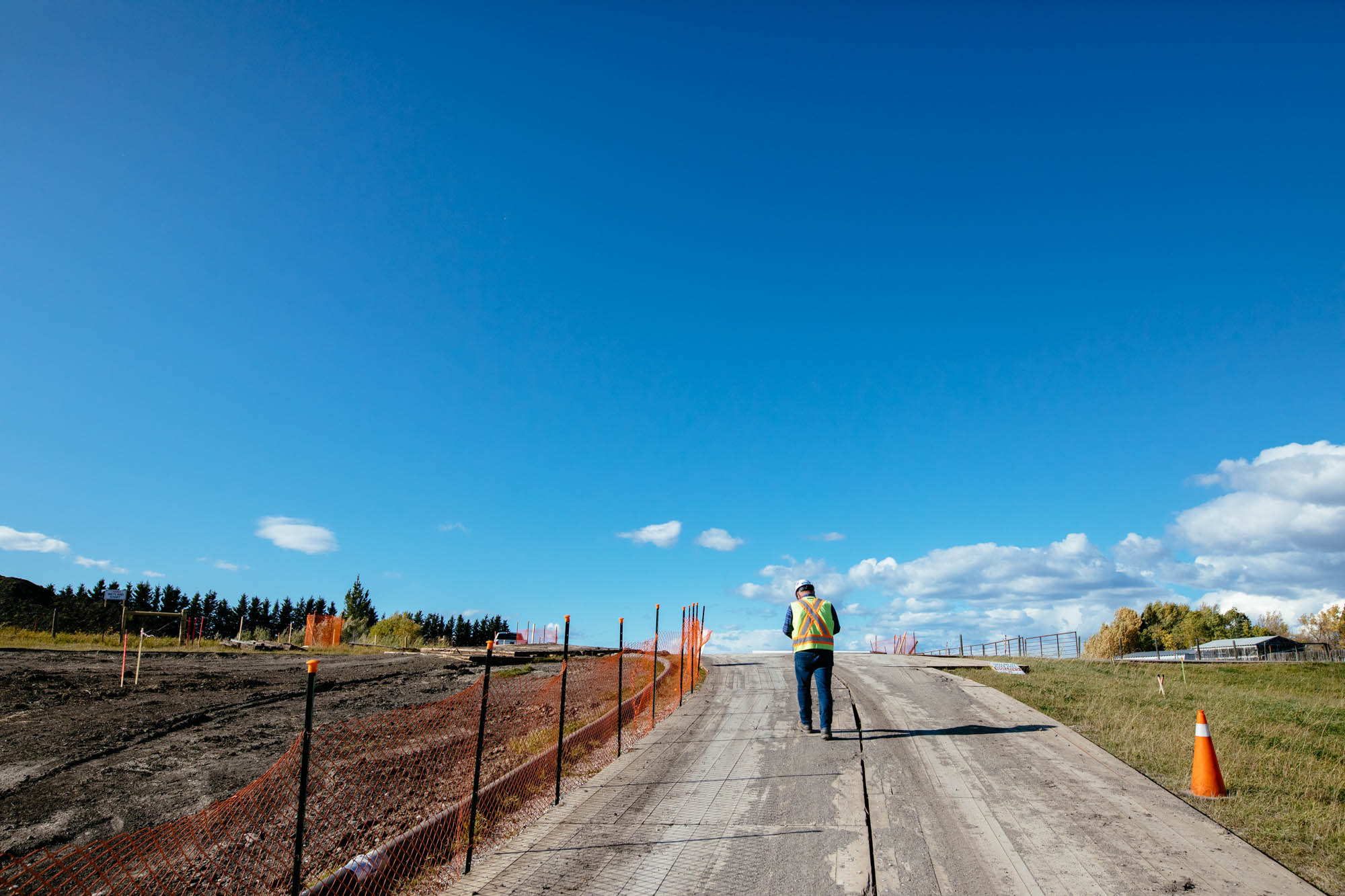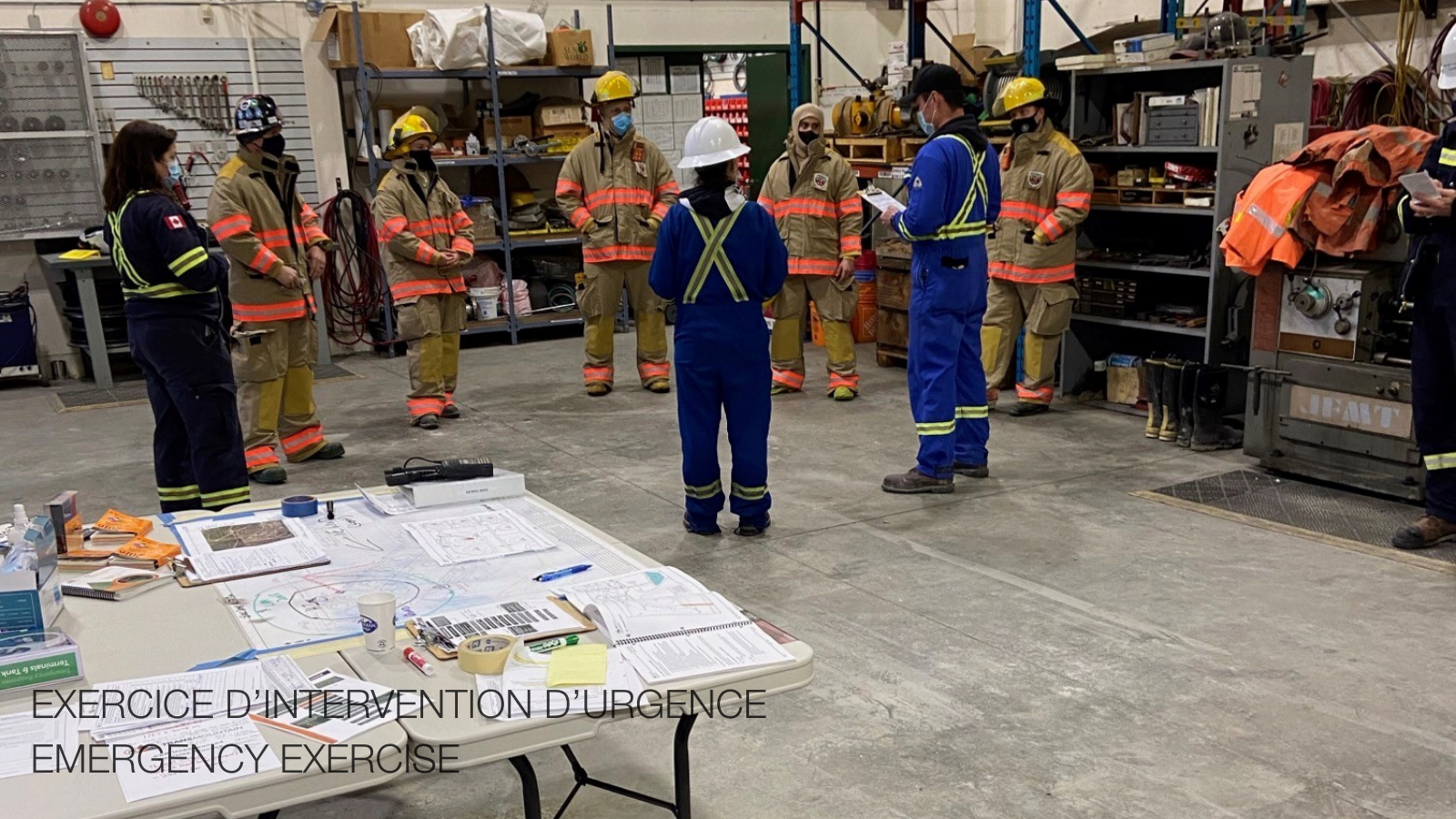Core Responsibilities: What we achieved
Safety and Environment Oversight
The Canada Energy Regulator works for Canadians to keep energy moving safely and efficiently through our country’s pipelines and powerlines. The organization carries out this function by setting and enforcing regulatory expectations for companies over the full lifecycle – construction, operation and abandonment – of energy related activities.
The CER’s commitment to keeping people safe is at the core of who it is and the work it does. Regulated companies are also required by the CER to anticipate, manage, and mitigate any potential harm to safety and the environment that may occur through the full lifecycle of their energy facilities.
The CER also promotes best practices to reduce the potential for harm and engages with the public, contractors, landowners, and municipalities to promote actions they can take to prevent damage to pipelines.
Our Commitment:
- Harm to people and the environment, through the lifecycle of energy-related infrastructure, is prevented.
Performance Results Summary – Safety and Environment Oversight
| Performance Measure1 | Target: | Results 2018-19 | Results 2019-20 | Results 2020-21 |
| Number of serious injuries and fatalities related to regulated infrastructure. | 0 | 13 | 82 | 12 |
| Number of incidents related to regulated infrastructure that harm the environment. | 0 | 13 | 2 | 6 |
| Percentage of unauthorized activities on regulated infrastructure that involve repeat violators | <15% | 18% | 12% | 10% |
Compliance Activities
Preventing harm is the foundation of how the CER keeps people safe and protects the environment.
The CER aims to achieve zero incidents that harm people or the environment on the energy infrastructure it regulates. The CER follows a risk-based approach in planning and conducting compliance verification activities (CVAs) and when the activities of regulated companies have the potential to pose greater harm to people or the environment, the CER focuses increased oversight through engagement, inspections, investigations, audits and enforcement, when necessary.
In 2020-21, the CER conducted 215 CVAs, which included:

Overall, there were about thirty-five fewer CVAs in 2020-21 due to the COVID-19 pandemic.

Trans Mountain Expansion Project (TMEP)
In 2020-21, Trans Mountain continued its construction activities on the TMEP pipeline. Throughout this time, the CER worked to hold the company accountable and verify that it was meeting its requirements and commitments through compliance verification activities and ensuring that Trans Mountain was satisfying all 156 conditions of the pipeline’s approval.
The CER’s efforts were informed by the Trans Mountain Indigenous Advisory Monitoring Committee and in collaboration with Indigenous Monitors.
During the course of the year, the CER undertook over fifty CVAs on the Trans Mountain Expansion Project; that work covered pipeline integrity, safety, environmental protection, damage prevention, and emergency management. The activities included thirty-two inspections, two emergency management exercises and twenty compliance meetings.
Tragically, a contract worker was fatally injured in October 2020 at a TMEP construction site in Edmonton, Alberta. In December 2020, a contract worker was seriously injured on a TMEP construction site in Burnaby, BC. In each case, CER staff were immediately deployed to conduct inspections and oversee the investigations conducted by the company and its contractor.
In response to the worker fatality, the CER issued an Inspection Officer Order to Trans Mountain, halting the use of trenching equipment and directing the company to conduct a comprehensive investigation of its contractor oversight practices.
In light of the incidents, Trans Mountain halted construction on the pipeline in mid-December 2020. Construction was restarted in February 2021.
Trans Mountain later submitted their root cause analyses for the incidents, which included but was not limited to, critical factors such as incorrect dismantling of the trench box by the contractor and contributing factors such as inadequate communication, inadequate leadership/supervision, and inadequate development of standards and procedures.
Subsequently, there were five compliance activities associated with these two events and an ongoing CER enforcement investigation of the fatality incident.
CER Tests Trans Mountain Fire Response Preparedness
In March 2020, the CER conducted its first ever unannounced exercise to evaluate a regulated company’s emergency readiness.
On that day, CER Inspectors and an Indigenous Monitor arrived at Trans Mountain’s Burnaby facility with no prior warning given to the company that the CER would be initiating the exercise. Trans Mountain was directed to simulate a response to a full surface crude oil tank fire. The company had to show that it could get the needed personnel and equipment on site and ready to start extinguishing the fire within four hours to allow ample time to control a potential boil-over from the tank itself.
Initial findings indicated that Trans Mountain was able to respond to the potential scenario at its Burnaby facility in 2.5 hours, well within the four-hour target. Overall, no safety, or other issues including significant deficiencies or plan deviations were noted or observed by the CER or the Indigenous monitor. For more details see the report from the compliance activity.
The CER requires companies to be ready at all times to respond to any emergency related to their work and this new type of assessment demonstrates the CER’s commitment to safety and innovation.
CER regulations outline what companies must do to prepare for an emergency. The CER makes sure that a company can respond effectively by evaluating emergency response exercises, reviewing emergency management programs, conducting emergency management inspections and by reviewing company Emergency Procedures Manuals. When companies do not meet requirements, the CER has the authority to take action to bring the company back into compliance so they are operating safely.

Enbridge Line 3 Replacement Program
Construction on the Line 3 Replacement Project was largely completed during the 2020-21 fiscal year, therefore the CER’s compliance oversight in that time focused on post-construction activities.
Compliance verification activities on Line 3 were carried out in the field with Indigenous Monitors from the Line 3 Indigenous Advisory Monitoring Committee.
CER Oversight of Keystone XL
Construction activity on the Keystone XL pipeline occurred in the latter part of 2020. During that time, the CER conducted compliance verification activities with the assistance of Indigenous Monitors.
In January 2021, the U.S. federal government revoked the Presidential permit for the Keystone XL Project. Subsequently, TC Energy began winding down its construction activities in Canada while the CER continued its regulatory oversight activities.
NOVA Gas Transmission Ltd. 2021 System Expansion Project
Construction activity on the NOVA Gas Transmission Ltd. 2021 System Expansion Project began in early 2021. In that time, the CER began a process to ensure the involvement of Indigenous Monitors3 in its regulatory oversight work of the Project.

Energy Adjudication
The CER regulates and adjudicates upon applications, which include environmental assessments, using processes that are fair, transparent, timely and accessible. These applications pertain to pipelines and related facilities, international power lines, tolls and tariffs, energy exports and imports, oil and gas exploration and drilling in certain northern and offshore areas of Canada as well as future offshore renewable energy projects.
Additionally, the CER regulates Canada’s federal energy infrastructure over its complete lifecycle. During the design and application assessment phase of projects, it reviews and imposes conditions. Companies must satisfy the CER that they are fulfilling the conditions set in an application review, and that they are taking every available action to anticipate, prevent, and mitigate any potential harms associated with their activities. When a project has reached the end of its useful life, the CER reviews abandonment applications to ensure that they are abandoned in a safe and environmentally responsible manner.
The CER Act outlines the way resource projects are assessed by the CER. The legislation focuses on early planning and engagement during project reviews, Indigenous engagement and the incorporation of Indigenous knowledge and rights, as well as an emphasis on public participation opportunities
Advancing Canada’s global competiveness is core to the CER’s mandate. The organization is committed to making decisions in a predictable and timely manner, adhering to service standards, providing certainty to investors and stakeholders, driving innovation and enabling the carrying out of sound projects that create jobs for Canadians.
For further details on adjudicative decisions and recommendations to the Governor in Council from the CER, please see the 2020-21 Annual Report of the Commission of the Canada Energy Regulator.
Our Commitment
- Energy adjudication processes are fair, timely, transparent and accessible.
Performance Results Summary – Energy Adjudication
| Performance Measure | Target | Results 2018-19 | Results 2019-20 | Results 2020-21 |
| Percentage of adjudication decisions overturned on judicial appeal related to procedural fairness. | 0% | 0% | 0% | 0% |
| Percentage of adjudication decisions and recommendations that are made within legislated time limits and service standards | 100% | 100% | 100% |
97% -Time Limits |
| Percentage of surveyed participants who indicate that adjudication processes are transparent. | 75% | 73% | 79% | 80% |
| Percentage of surveyed participant funding recipients who agree that participant funding enabled their participation in an adjudication process. | 90% | 100% | 100% | 100% |
CER Commission
One of the highlights of the modern governance structure of the CER is the establishment of an independent Commission to adjudicate upon energy projects.
The Commission is part of the CER and although its adjudicative role is independent, it contributes to the overall effective delivery of the CER’s mandate and Departmental Results Framework. Specifically, the Commission contributes to the CER’s core responsibilities of Energy Adjudication and Safety and Environment Oversight.
Orphan Pipelines
The CER Act introduced provisions for dealing with pipelines where the company that holds the pipeline certificate is unknown, insolvent, dissolved or cannot be located. The CER established a Designated Officer and can now take necessary measures to abandon an orphaned pipeline, if required.

Crown Consultation Process
In 2020-21, the CER delivered Crown consultation activities4 with the guiding principle of advancing reconciliation with Indigenous peoples. For the CER, this meant emphasizing early and collaborative exchanges with Indigenous peoples based on a recognition of rights and enhancing the transparency of the Crown consultation process.
The CER’s Crown Consultation Team consulted Indigenous communities in relation to a number of applications throughout 2020-21, such as;
- ITC’s application for a variance to the ITC Lake Erie IPL certificate sunset clause;
- TC Energy’s NGTL application for the Westpath 2023 pipeline project; and
- Trans Mountain’s West Alternative route variance application.
At year-end, these review processes and corresponding Crown activities were still ongoing. As the CER implements its Crown consultation role, it will look for opportunities to continually improve its approach - listening and learning from Indigenous peoples.
Improvements to the Participant Funding Program
The CER administers a Participant Funding Program to facilitate the participation of the public - in particular, the Indigenous peoples of Canada and Indigenous organizations - in public hearings and any steps leading to those hearings.
In 2020-21, a gap was identified in the Program whereby the CER was unable to provide participant funding for CER-led hearings of non-designated projects conducted under the Canada Oil and Gas Operations Act and the Northwest Territories Oil and Gas Operations Act, which could create a legal risk of the CER failing to fulfil the duty to consult.
CER staff worked with several federal government departments to assess the gap and identify options. On 24 March 2021 the Minister of Natural Resources approved amendments to the Participant Funding Program’s Terms and Conditions to allow the CER to provide participant funding to Indigenous groups for such northern hearings. The CER is planning to issue grants to Indigenous groups for two northern project applications expected to require hearings in 2021-22.

Energy Information
The CER collects, monitors, analyzes and publishes information on energy markets and supply, sources of energy and the safety and security of pipelines and international power lines.
The increasing pace of change in Canadian and global energy markets and climate policy suggest that the need for up-to-date analysis on energy trends is greater than ever.
The CER plays a vital role in conveying objective and neutral information to Canadians and is at the forefront on energy markets monitoring and analysis. Staff work feeds into regulatory hearings on pipeline projects in Canada, provides analysis on important policy developments, models Canada’s energy supply and demand projections, and provides Canadians with reports and dashboards to help make informed choices on energy matters.
Our Commitment
- Shape and strengthen the CER’s contributions to the new Government of Canada energy information initiative, the Canadian Centre for Energy Information.
- Increase access to neutral and fact-based energy analysis to inform Canada’s energy conversation.
- Broaden collaboration with stakeholders and partners.
- Publish informative products that are beneficial to a diverse audience, and reflect Canada’s diversity of relevant energy issues in an engaging and transparent way.
Performance Results Summary – Energy Adjudication
| Performance Measure | Target | Results 2018-19 | Results 2019-20 | Results 2020-21 |
| Number of times CER Energy Information is accessed. | 750,000 | 1,216,873 | 1,273,727 | 1,169,612 |
| Increased information specific to CER-regulated infrastructure in communities. | 5 new data sets | 15 | 6 | 15 |
| Percentage of surveyed web users who agree that energy information is useful for knowledge, research and decision-making. | 75% | 90% | 79% | N/A5 |
| Number of opportunities that Canadians have to collaborate and provide feedback on energy information products. | 80 | 105 | 56 | 113 |
The Canadian Centre for Energy Information
The CER works to provide the energy information that the public and industry demand in order to make informed decisions.
As part of that commitment, the CER collaborated with several federal departments - including Natural Resources Canada, Environment & Climate Change Canada, and Statistics Canada - to establish the Canadian Centre for Energy Information (CCEI), which has a mandate to develop a modern, Pan-Canadian energy information system that provides easy-to-access, comprehensive, and credible information
The CCEI provides Canadians with a single point of access to a wide variety of statistics and measures of the country’s energy sector. Its website, launched in October 2020, offers an array of information on topics such as energy production, consumption, international trade, transportation and prices.
The initiative will benefit anyone interested in obtaining data on energy who may not have prior knowledge of where or how to find that information. It will also create a more efficient mechanism for both the CER and Canadians who regularly use energy data.
More and more, that information will focus on Canada’s energy transition, including projections on energy production and consumption in our lower carbon future.
The CER works to provide the energy information that the public and industry demand in order to make informed decisions.
Informing Canada’s Energy Conversation
The CER produces neutral and fact-based energy analysis to inform the energy conversation in Canada. Providing access to relevant, accurate and timely energy data and information gives Canadians tools they need to do their own research, make decisions and understand the energy landscape around them. By increasing energy awareness, the CER supports Canada’s global competitiveness in energy markets.
Higher profile energy analysis that the CER released in 2020-21 included the Energy Futures 2020 Report as well as Canada’s Renewable Power Report.
Energy Futures 2020 is the CER’s long-term energy supply and demand outlook. The report introduced a new scenario that explored Canada’s energy transition and examined the opportunities and challenges for Canada associated with net-zero GHG emissions by 2050. The report generated considerable dialogue - in the media, on social media and with energy experts - about the future of energy in Canada. Within 24 hours of the public release of Energy Futures 2020, there were over 770 social media posts and 450 news articles and broadcast mentions of the report.

The CER also released Canada’s Renewable Power in March, which is a national, provincial, and territorial level overview of electricity generation and capacity. The report included a short-term outlook of capacity changes in Canada and illustrated the path forward for the decarbonization of Canada’s electricity grids. The release of Canada’s Renewable Power attracted considerable national media attention, as over 250 news platforms - with a combined audience reach of 240 million people - mentioned the report.
During the 2020-21 fiscal year, the CER’s Energy Information products, reports and statistics included:
- 60 new online energy information products
- 14 Reports and 46 Market Snapshots
- More than 1.1 million energy information web page views
- 208 information request responses
- 113 collaborative engagements with energy stakeholders
- 119 citations of energy and pipeline information sourced as a reference in major online publications
Increasing Collaboration – Broadening the CER’s Reach
Policymakers, regulators and stakeholders need high quality energy information for a modernized energy system to work well. For that reason, the CER worked to develop deeper connections and broader collaboration with stakeholders and partners in 2020-21.
The organization worked with other departments and agencies within the Government of Canada, as well as international institutions, to provide Canadians with greater access to data and data sets. The intent of this approach was to increase the scope and reach of CER energy information expertise and to improve the Canadian energy information landscape.
The CER worked with Statistics Canada to improve the quality of monthly trade data for both agencies and co-authored a publication on crude oil exports. The CER also collaborated with Statistics Canada and the Canada Border Services Agency to enhance the CER’s energy trade data holdings.
The CER undertook a collaborative research project and paper with CanmetENERGY, Natural Resources Canada, and the National Research Council on “Open and common approaches for evaluating marginal emission factors: a case study of the Alberta electric grid.”

Engagement
The CER engages with stakeholders and Indigenous peoples on topics within the Canada Energy Regulator’s mandate and role, beyond the engagement that occurs on specific projects.
To prevent harm, keep Canadians safe, protect the environment and prevent market inefficiencies, the CER is committed to listening and sharing the unique information it has as a regulator.
Engagement leads to more informed decisions and recommendations that prevent harm, keep people safe and the environment protected. Engagement also supports public transparency across every aspect of the CER’s work.
Put simply, when the CER incorporates what it hears from Canadians, it builds relationships and awareness, it improves its own work, and it builds trust and confidence in its work as a regulator.
Our Commitment
- The CER engages with Indigenous peoples and stakeholders.
- The CER is fundamentally transforming the way it works with the Indigenous peoples of Canada with a commitment to implementing the United Nations Declaration on the Rights of Indigenous Peoples by:
- enhancing their involvement in how we discharge our mandate recognizing their unique cultures, knowledge and histories, and
- building renewed relationships based on the recognition of rights, respect, co-operation and partnership.
Performance Results Summary - Engagement
| Performance Measure6 | Target | Results 2018-19 | Results 2019-20 | Results 2020-21 |
| Evidence that input from Indigenous Peoples and stakeholders influences CER’s decisions and work. | Narrative | N/A | N/A |
BC Oil and Gas Commission and the CER finalized a one-year pilot project with the Aboriginal Liaison Program. Each CEO has signed a Service Agreement and CER transferred $150,000 to BCOGC. The CER’s involvement will create new opportunities for collaboration with participating Indigenous communities and provincial agencies as we develop meaningful partnerships and relationships. |
| Percentage of participants in engagement activities who indicate that the engagement was meaningful. | 75% | 89% | 84% | 80% |
Engaging with Indigenous Peoples and Stakeholders
The CER’s engagement programs support engaging nationally and regionally with Indigenous Peoples and stakeholders through open dialogue, asking questions, sharing perspectives, and collaboration.
Despite the challenges the pandemic brought in 2020-21, the CER was able to engage with stakeholders and Indigenous peoples by adapting its processes to deliver engagement virtually.
Over the course of the year, the CER held 110 unique engagement events. In those meetings, the CER was able to identify issues and work to resolve them through communication and coordinated efforts across the organization, with regulated companies and provincial bodies.
Despite the limitations from the pandemic, 80% of stakeholder and Indigenous groups who completed the CER’s stakeholder survey indicated they had a meaningful engagement with the CER.
Engagement activities were conducted across all CER programs to inform decisions, regulations, products and other work. However, the organization noted that it needs to continue to improve the ways in which it coordinates and aligns its engagement efforts.
Stakeholder Engagement
Some of the highlights of the CER’s 2020-21 stakeholder engagement efforts included:
- Working with the BC Lower Mainland Municipalities to address issues such as cost apportionment and ground disturbance.
- Broadening the membership of the Land Matters Group Advisory Committee to create a more national forum where issues of interest to landowner associations, agricultural advocacy groups, industry and government representatives are discussed.
- Collaborating with the Canadian Electricity Association to facilitate the reporting of contraventions of the CER event reporting system.
- Improving internal systems to enable better delivery of stakeholder and Indigenous engagement on the Keystone XL and NGTL 2021 pipeline projects.
- Working as part of a stakeholder group on publication of the ‘Frame of Reference – Pipeline Response’ initiative, which will increase collaboration among first responders in Québec.
- Developing an Ontario stakeholder engagement strategy.
Indigenous Engagement
Some of the highlights of the CER’s 2020-21 Indigenous engagement efforts included:
- Implementing a plan for post-certificate engagement for the Keystone XL Pipeline – engaging six Indigenous Nations along the route before the U.S. federal government revoked the Presidential permit for the pipeline. A postcertificate engagement plan was also developed for the NGTL 2021 pipeline project, with engagement beginning in 2021-22.
- Completing 54 joint inspections with Indigenous Monitors on the Trans Mountain Expansion, Keystone XL, Line 3 and NGTL 2021 projects.
- Engaging the Indian Resource Council to seek their input on energy information that is included in the CER’s Market Snapshot publication.
- Holding multiple Indigenous Awareness activities with CER staff featuring guest speakers.
- Delivering cultural competency training to CER staff.
- (1) The CER revised its performance measures for Safety and Environment Oversight for 2020-21.
- (2) This number differs from what was reported in the 2019-20 Annual Report as it was amended after year end.
- (3) IAMCs bring together Indigenous representatives and Government of Canada counterparts to provide strategic oversight advice to government and regulators, and to monitor the construction and operation of the projects. As a part of its strategic oversight role, the IAMCs have Monitoring subcommittees. With the guidance of the broader IAMC, trained Indigenous Monitors work in the field with CER Inspection Officers before, during and after the inspections, enhancing the expertise of the inspection team.
- (4)
The duty to consult and, when required, accommodate, will be triggered when there is a potential impact to Indigenous or treaty rights and where a decision of the Government might adversely affect the exercise of those rights.
The CER’s new Crown consultation responsibilities will be part of project reviews for new pipelines, powerlines or offshore renewable energy projects, as well as for activities it regulates over the lifecycle of energy infrastructure.
- (5) Survey was not conducted in 2020-21 due to technical issues and very low response rates in previous years.
- (6) The CER revised its performance measures for Engagement for 2020-21.

